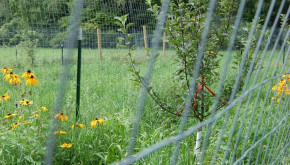
A fenced area 8 feet wide and 100 feet long may seem like a strange design choice, but it keeps the deer out of the apple orchard—and is just one of the many examples of how Kenna and Walt Levendosky creatively live in harmony with their land.
For many landowners, a relationship with the land is just like any other relationship in life—it requires an investment of time and effort, tends to change over the years, and comes with its own set of unique challenges. And, like any healthy relationship, the energy invested is returned tenfold.
Kenna, her sister Karen, and their father Ken Knapp protected their 220 acres of forests and meadows in Delaware County, NY in 2002. Though they had numerous offers to develop the land, the family refused them all, deciding instead to work with the Conservancy to protect the property with a conservation easement. Located on the West Branch of the Delaware River, the forests help to ensure that the water quality in the river—upstream of New York City’s Cannonsville Reservoir, a source of drinking water for millions—remains pristine. And the great blue herons and bald eagles that roost in their tall, healthy hemlock trees have safe habitat.
Now, Kenna and her husband Walt live on the property, and are finding that stewarding the land—or, more accurately, sharing a love of the land—is a way of life.
Kenna, who has attended two Women and Their Woods educational retreats, explains, “I think the whole family has to be involved in caring for the land—and women are at the heart of the family. They often spend the most time with the children, they get them outdoors—one of our granddaughters got into the woods and said ‘Oh, this is much better than the house!”
Protected lands also offer abundant opportunities for proactively making improvements. Their vegetable garden has room enough for dozens of plants that the family enjoys all year. For pollinators like butterflies and bees, the Levendoskys have planted bee balm, milkweed, thimbleberries, and goldenrod in their flower garden and orchard, and have installed nesting chambers for native bees in the form of bamboo tubes lined with parchment paper. To restore and stabilize their steep riverbank—the site of an old railroad track that is beginning to erode—they are planning a big planting project with native seed mixes and saplings.
Deciding to protect your cherished piece of land is only the beginning of a lifelong relationship. To truly steward the land is to strike a careful balance among resolving any problems that arise, making improvements that benefit nature and wildlife, and taking time to appreciate it for its inherent beauty and value.
To read more about ways landowners in the Upper Delaware River region of Pennsylvania and New York continue to protect and steward their lands, visit the Delaware highlands Conservancy’s website: www.DelawareHighlands.org. To learn more about conservation easements and contact information for a land trust in your region, visit the Land Trust Alliance website: http://www.landtrustalliance.org.
Article written by Bethany Keene, Outreach Coordinator at the Delaware Highlands Conservancy. Photo provided by Kenna Levendosky.

